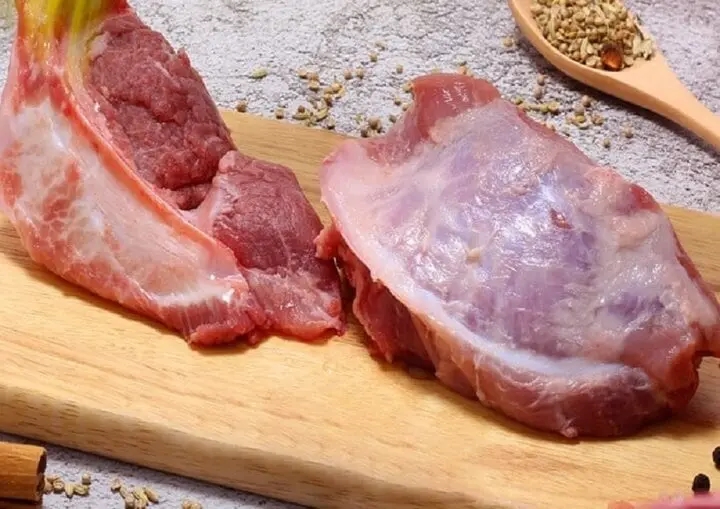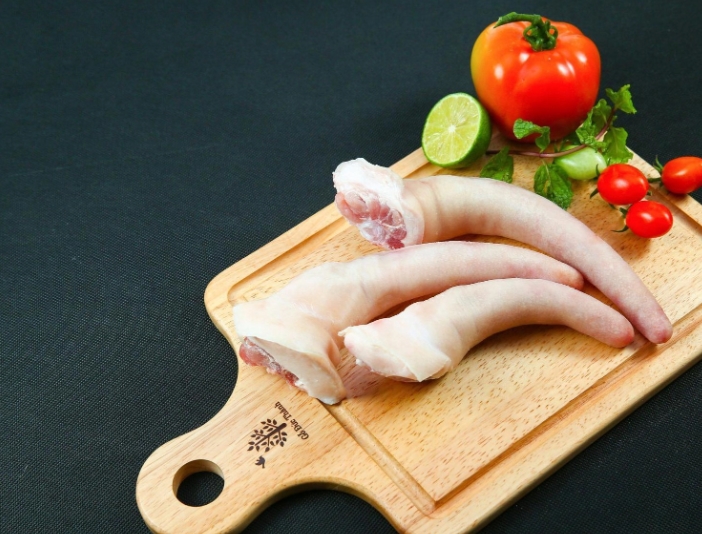When it comes to buying pork, most homemakers tend to opt for popular cuts like pork belly, shoulder, or loin as they are versatile and can be used in a variety of dishes. However, for many, the best part of the pig is something else entirely.
The tastiest part of the pig, with only 2kg per animal
While pork cartilage is delicious and loved by many, it’s not a daily choice for homemakers as it’s an acquired taste, and it takes longer to clean and cook than other cuts. The main reason for its lack of popularity, though, is its scarcity; there are only 2kg of this delicious meat per pig, and it’s not always available at the market. Restaurants and pubs often snap it up to create mouth-watering dishes for their customers.
The crescent-shaped cartilage, located at the junction of the front legs, is one of the most prized and tasty parts of the pig.
This curved bone, resembling a crescent moon, is mostly cartilage, resulting in a deliciously crunchy, tender, and sweet meat. Because of its scarcity and superior taste, butchers often keep it for themselves, sell it to regulars, or offer it to VIP customers.

This is the tastiest part, with only 2kg per pig.
The crescent-shaped bone, along with the surrounding meat, is considered the best part of the pig due to its sweet and fragrant meat, tender texture, and crunchy cartilage. Rich in collagen, it’s beneficial for joints, skin, and hair, and it’s especially good for women who want to improve their skin health.
The crescent-shaped bone is also a great source of protein and contains soluble nitrogen extracts, providing the body with abundant and high-quality nutrition.
The cartilage in this bone is also rich in calcium, phosphorus, and some vitamins, making it a great choice for those looking for a nourishing meal. Trace elements like vitamins and minerals play a crucial role in a healthy diet, boosting the immune system and protecting against diseases.
As there are only about 2kg of this delicious meat per pig, those who want to buy it often have to place a special request with their butcher. This versatile cut can be grilled, boiled, or stir-fried with vegetables.
Other Delicious and Prized Pork Cuts
In addition to the crescent-shaped bone, the following cuts are also highly sought-after for their exceptional taste.
Peach Cheek Meat
This cut is considered “5-star quality” and is often sold out by morning. This is why many people are unaware of its existence.
Pork cheeks come in two parts: the outer cheek and the inner peach cheek. While the outer cheek is tasty, it tends to be fatty. The peach cheek, on the other hand, has a unique texture with soft tendons running through the meat. This cut is perfect for those who don’t like dry or overly fatty meat.
Loin (Lean Loin)
The loin is pure lean meat with fine grain, a tight texture, and a high degree of adhesion. It has a fragrant aroma, a rich flavor, and a low-fat content, making it suitable for those on a diet or with a sensitive stomach or digestive issues. Recommended cooking methods include boiling, steaming, stir-frying, deep-frying after coating with flour, stewing, and slicing thinly for rolls. It can also be baked in the oven, grilled, or minced for soup.
Front Leg Shank
The front leg shank is mostly lean meat with a firm, chewy texture and a rich, fragrant flavor. It’s best suited for stewing, braising, or boiling, and the cooked meat can be sliced and steamed.
Shoulder
The shoulder cut is located at the top, near the spine of the front leg, right next to the jowl. This cut has a mix of lean meat and fat, with the lean meat being more prominent. The texture is smooth and soft, appealing to most palates, and while it contains fat, it’s not overwhelming. The shoulder is often minced for meatballs or other minced meat dishes and is also suitable for steaming, frying, etc.
Ham (Upper Hind Leg)
The ham, or upper hind leg, borders the rump near the hind leg shank. This cut is usually pure lean meat with a fragrant aroma, a soft texture, and plenty of juices. The best way to cook it is by hot pot, steaming, boiling, or slicing thinly to stir-fry.
Tail
Each pig has only one small tail, so it’s not always available for purchase. Many butchers even keep the tail for themselves to enjoy at home.

Pig tail is also one of the most nutritious parts of the pig.
Rich in collagen, pig tails are great for your health and beauty. They provide high-quality protein, and when consumed in moderation, they can help build muscle without the fear of gaining fat. Pig tails can be used in soups, boiled, grilled, or braised, and they taste delicious.
Pig Skin
Many people discard pig skin when buying pork, but it’s actually one of the most nutritious parts. Not only is it delicious, but it also has beauty benefits.
According to studies, pig skin contains twice the amount of protein as pork and four times the amount of carbohydrates. Moreover, 90% of pig skin is made up of collagen and elastin, which can slow down skin aging for women.
Pig skin has a cooling property, a sweet taste, and is effective in hemostasis and blood tonification.
According to VTC News
A Pig Has a 2-Ounce Organ: Precious as 100-Year-Old Ginseng, Eating It Won’t Make You Gain Weight
Delicious, nutritious, and often overlooked, the juicy and succulent meat from the cheek of a peach is a hidden gem waiting to be savored. Bursting with flavor, this delectable treat offers a unique combination of sweetness and tanginess. Not only is it a delightful indulgence for the taste buds, but it also packs a powerful punch in terms of nutrients. Packed with vitamins, minerals, and antioxidants, the peach cheek meat is a wholesome addition to any diet. So, next time you bite into a juicy peach, don’t forget to savor the delectable goodness of its cheek meat.
































